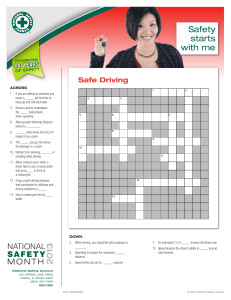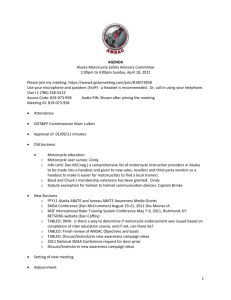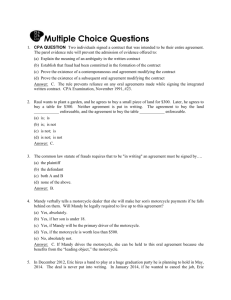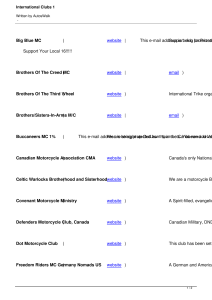Apply precise control in riding a road motorcycle
advertisement
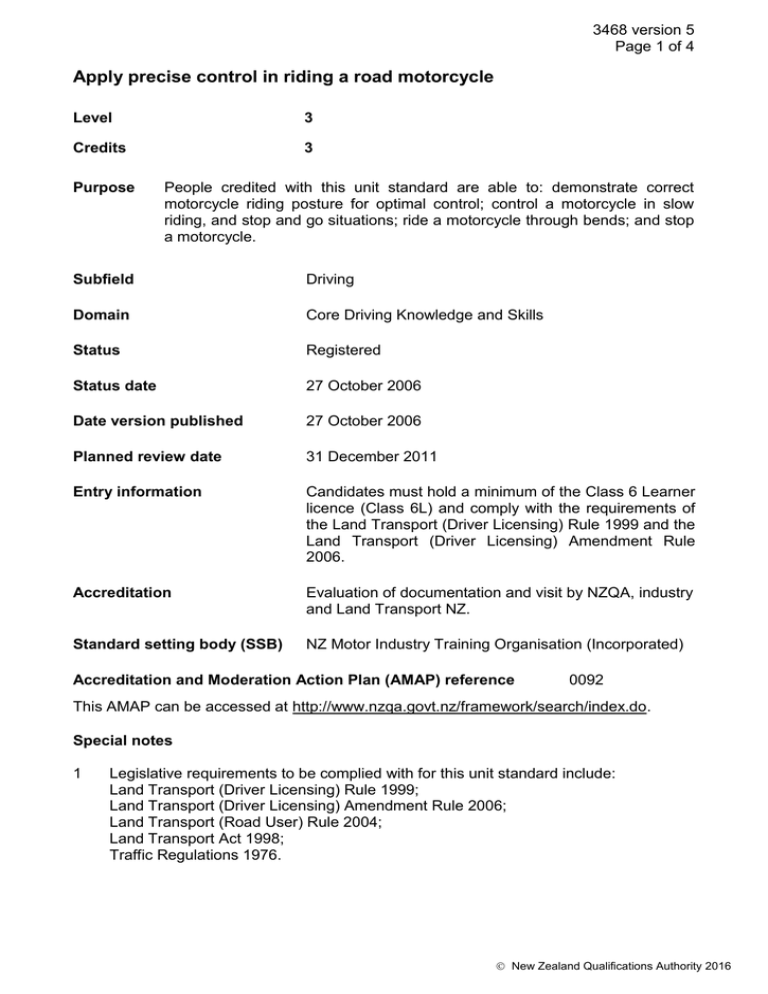
3468 version 5 Page 1 of 4 Apply precise control in riding a road motorcycle Level 3 Credits 3 Purpose People credited with this unit standard are able to: demonstrate correct motorcycle riding posture for optimal control; control a motorcycle in slow riding, and stop and go situations; ride a motorcycle through bends; and stop a motorcycle. Subfield Driving Domain Core Driving Knowledge and Skills Status Registered Status date 27 October 2006 Date version published 27 October 2006 Planned review date 31 December 2011 Entry information Candidates must hold a minimum of the Class 6 Learner licence (Class 6L) and comply with the requirements of the Land Transport (Driver Licensing) Rule 1999 and the Land Transport (Driver Licensing) Amendment Rule 2006. Accreditation Evaluation of documentation and visit by NZQA, industry and Land Transport NZ. Standard setting body (SSB) NZ Motor Industry Training Organisation (Incorporated) Accreditation and Moderation Action Plan (AMAP) reference 0092 This AMAP can be accessed at http://www.nzqa.govt.nz/framework/search/index.do. Special notes 1 Legislative requirements to be complied with for this unit standard include: Land Transport (Driver Licensing) Rule 1999; Land Transport (Driver Licensing) Amendment Rule 2006; Land Transport (Road User) Rule 2004; Land Transport Act 1998; Traffic Regulations 1976. New Zealand Qualifications Authority 2016 3468 version 5 Page 2 of 4 2 Any new, amended or replacement Acts, regulations, Rules, standards, codes of practice, or Land Transport New Zealand requirements or conditions affecting this unit standard will take precedence for assessment purposes, pending review of this unit standard. 3 Definitions A normal stop is one that involves stopping progressively in a controlled manner before there is any urgency. A controlled quick stop is one requiring urgent but controlled application of the brakes. Stopping may be in less than an optimal distance for safety and may result in controlled skidding. Optimal distance for safety means the shortest practicable stopping distance with no loss of control. Riding refers to being in control of a motorcycle. A slope is a gradient on which braking must be applied to prevent a stationary motorcycle from moving. 4 Reference material The Official New Zealand Road Code and Licence Guide for Motorcyclists, (current version), available from booksellers, reflects legal requirements but does not override governing legislation. 5 Competency in this unit standard requires that all actions comply with traffic law, and evidence indicates that all actions are carried out in a manner that avoids actual or potential danger to other road users and to the rider of the motorcycle. The rider must be seated at all times. 6 This unit standard applies to two-wheeled motorcycles, which may include mopeds. Candidates with a Class 6L licence must ride a motorcycle appropriate to that class of licence. Elements and performance criteria Element 1 Demonstrate correct motorcycle riding posture for optimal control. Performance criteria 1.1 Correct motorcycle riding posture is demonstrated consistently and permits rapid and correct application of all hand and foot controls. New Zealand Qualifications Authority 2016 3468 version 5 Page 3 of 4 Element 2 Control a motorcycle in slow riding, and stop and go situations. Range from 0-10 km/h, on the level, up a slope, down a slope. Performance criteria 2.1 Coordination of motorcycle clutch and throttle controls during slow riding prevents stalling and over-revving, and enables smooth travel. Range 2.2 starting, stopping, changing speed. Only the foot on the side opposite to the footbrake is down while stopped, unless the road camber requires otherwise for safety reasons. Element 3 Ride a motorcycle through bends. Performance criteria 3.1 Motorcycle is ridden through bends with lane position and smooth directional control maintained, and at a speed safe for the conditions. Element 4 Stop a motorcycle. Performance criteria 4.1 Motorcycle is brought to a normal stop from 30-40 km/h in an optimal distance for safety while riding in a straight line. 4.2 Motorcycle is brought to a normal stop from 30-40 km/h in an optimal distance for safety while riding through a bend. 4.3 Motorcycle is brought to a controlled quick stop from 30-40 km/h while riding in a straight line. Please note Providers must be accredited by the Qualifications Authority, or an inter-institutional body with delegated authority for quality assurance, before they can report credits from assessment against unit standards or deliver courses of study leading to that assessment. Industry Training Organisations must be accredited by the Qualifications Authority before they can register credits from assessment against unit standards. Accredited providers and Industry Training Organisations assessing against unit standards must engage with the moderation system that applies to those standards. New Zealand Qualifications Authority 2016 3468 version 5 Page 4 of 4 Accreditation requirements and an outline of the moderation system that applies to this standard are outlined in the Accreditation and Moderation Action Plan (AMAP). The AMAP also includes useful information about special requirements for organisations wishing to develop education and training programmes, such as minimum qualifications for tutors and assessors, and special resource requirements. Comments on this unit standard Please contact the NZ Motor Industry Training Organisation (Incorporated) info@mito.org.nz if you wish to suggest changes to the content of this unit standard. New Zealand Qualifications Authority 2016
